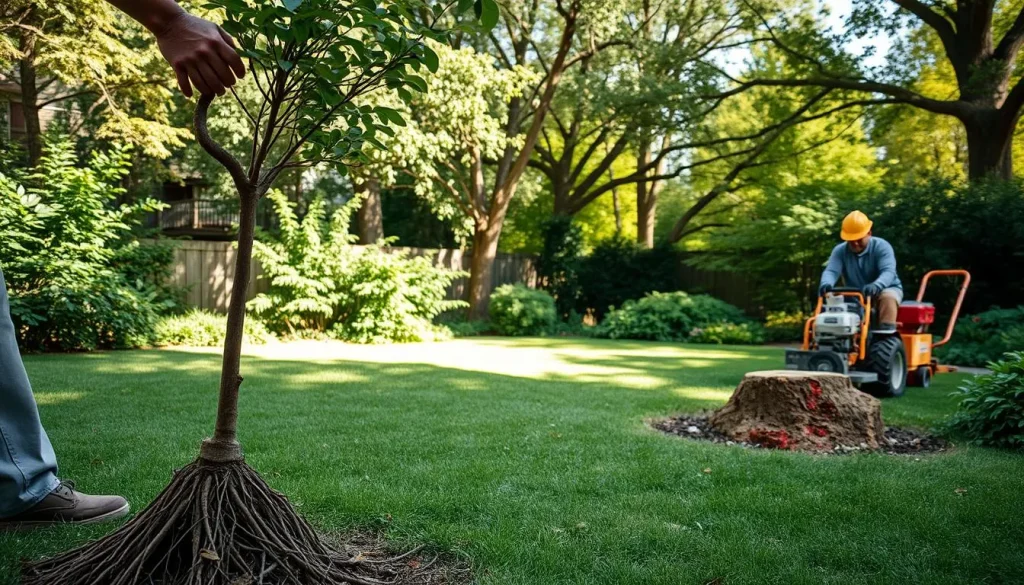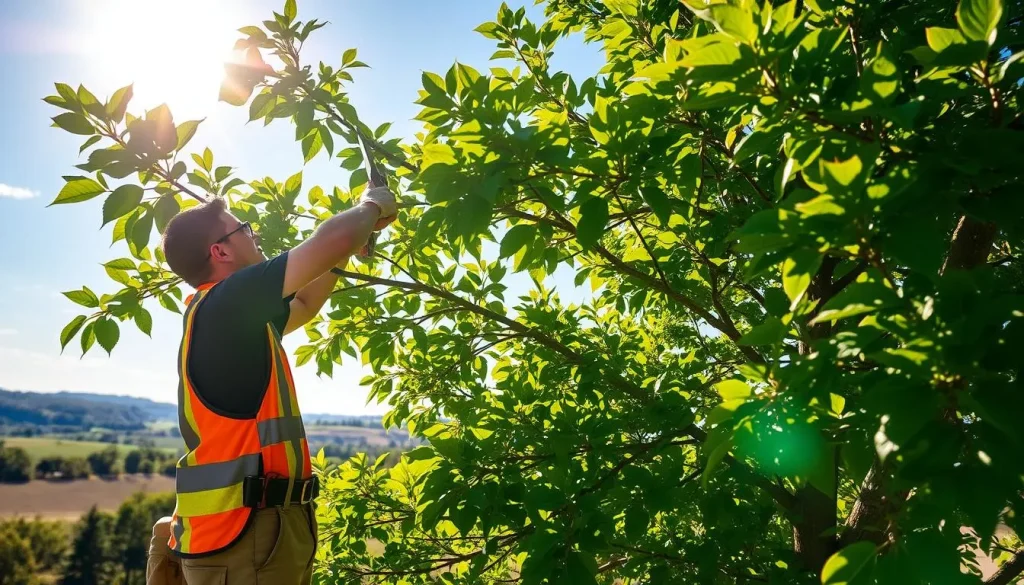Do you wonder how long do trees live when you walk in the woods? Or when you look at the big oak tree in your yard? Trees live longer than almost any other living thing on Earth. Some trees live for thousands of years. Others live for just a few decades. Knowing about tree lifespans helps us love these amazing plants more. It also helps us make better choices about planting and caring for trees. From the tall redwoods in California to the small fruit trees in your garden, each type of tree has its own way to live a long time. This still amazes scientists and nature lovers today.
Table of Contents
Tree Lifespans Across Different Species
The question “how long do trees live” has many answers. Tree lifespan varies a lot between different types of trees. It also depends on where they grow and how we care for them. Some trees live less than 30 years. Others have been alive for thousands of years. They have seen many generations of people come and go.
Short-Lived Trees (10-50 Years)
Many fast-growing trees have short lives. But they still do important jobs in nature. Fruit trees like apple and peach trees live 15-50 years. This depends on the type and how well we care for them. These trees use their energy to grow fast and make fruit. They don’t focus much on living a long time.
Paper birch trees live 30-40 years. Willow trees live 40-75 years. These trees grow quickly and make seeds early in life. This makes them important first trees in new forests.
Medium-Lived Trees (50-200 Years)
Most common yard trees and forest trees fit in this group. Pine trees live 50-200 years. Some types like Eastern white pine can reach 250 years if they grow in perfect spots.
Maple trees live 80-100 years. Sugar maples can live up to 300 years. Elm trees normally live 100-150 years. But a disease called Dutch elm disease has killed many elm trees. This has made their lives much shorter in many places.
The World’s Longest-Living Tree Species
Some tree types are really good at living a long time. They survive for hundreds or thousands of years. These old giants teach us about tree longevity factors. They show us how trees adapt to their world.
Oak Trees: Centuries of Strength
Oak trees are famous for living a very long time. They live 200-300 years. Some special ones live even longer. The Angel Oak in South Carolina is 400-500 years old. Oaks live so long because they have strong wood. They have deep roots. They can fight off diseases well.
Redwoods: Living Skyscrapers
Giant sequoias and coast redwoods are some of the oldest living things on Earth. These huge trees can live over 2,000 years. Some are over 3,000 years old. The General Sherman tree is a giant sequoia in California. It is 2,300-2,700 years old.
Ancient Bristlecone Pines
Bristlecone pines are the best at living a long time. These tough trees grow high up in the mountains of the western United States. They can live over 5,000 years. The oldest known living tree is a bristlecone pine named Methuselah. It is about 4,850 years old.
Key Factors That Determine How Long Trees Live
Knowing what makes trees live longer helps us understand something important. Some trees live for thousands of years. Others can only live for a few decades. Several things work together to decide tree longevity.
Environmental Conditions
Climate is very important for how long trees live. Trees in steady, mild weather live longer than trees in harsh weather. But some tree types have learned to live in tough places. They actually live a long time because of these hard conditions.
Soil quality directly affects tree health and how long they live. Good soil drains well and has lots of food for trees. This helps roots grow strong and fight disease. Bad soil makes trees weak. It hurts their ability to stay healthy and stand strong.
Species-Specific Characteristics
Different tree types have learned different ways to survive. Slow-growing trees often live longer than fast-growing ones. This is because they spend more energy making strong wood. They also get better at fighting disease. They don’t spend all their energy growing fast.
Wood density strongly connects to how long trees live. Trees with thicker, harder wood live longer. Their strong wood fights off rot better. It also handles bug damage and bad weather better.
Human Impact and Care
People greatly affect how long trees live. Proper tree care includes good watering, cutting bad branches, and treating diseases. This can make a tree live much longer. Bad care, building damage, pollution, and ignoring trees can make them die much sooner.
Urban environment stress often makes city trees live shorter lives than forest trees. City trees face many problems. The soil gets packed down hard. They don’t have enough room for roots. They breathe dirty air. Salt from roads hurts them too.
What Kills Trees: Common Threats to Tree Longevity
Learning about tree mortality factors helps us understand why some trees don’t live as long as they could. It also shows us how to protect these important plants better.
Disease and Pests
Fungal diseases are one of the biggest dangers to tree health. Dutch elm disease, oak wilt, and root rot have killed millions of trees around the world. These germs can kill even healthy, big trees in just months or years.
Insect pests like emerald ash borer and mountain pine beetle can quickly kill trees. They attack the tree’s system that moves water and food. They also make trees weak by eating holes in them.
Environmental Stresses
Drought stress makes trees weak. It makes them easy targets for other problems. Long dry times can kill trees directly. They can also make trees so weak that diseases and bugs can kill them.
Extreme weather events like hurricanes, ice storms, and strong winds can end a tree’s life right away. They can also cause damage that makes the tree get sick and die over time.
Maximizing Tree Lifespan in Your Landscape
We can’t control everything that affects how long trees live. But good care and choosing the right trees can make trees in our yards live much longer.
Choosing Long-Lived Species
When you plant trees, pick types that live a long time. Oak trees, maples, and certain pine species are beautiful and can live for over 100 years with good care.
Learn about your local growing conditions. Pick tree types that like your weather. Native trees usually live longer. They need less care than trees from other places that struggle with local conditions.
Proper Planting and Early Care
Correct planting techniques set up trees for a long life. Plant at the right depth. Make sure water drains away well. Give roots plenty of room to grow.
The Science Behind Ancient Trees
Young tree care during the first 5-10 years greatly affects how long the tree will live. Water them regularly. Give them the right plant food. Protect them from damage. This helps create healthy trees that can live their full possible lifespan.
Genetic Factors in Tree Longevity
New research has found amazing facts about how trees live for such a long time. Scientists who study ancient trees have learned that these plants have special cell and gene features. These help them fight the aging that affects most living things.
Some tree types have special genes that help them keep their cells healthy for very long times. These include better ways to fix damaged DNA. They also resist cell damage from bad weather and other stresses.
Compartmentalization lets trees wall off damaged or sick parts. This stops problems from spreading to the whole tree. This amazing healing power helps trees live a long time.
Growth Patterns and Longevity
Indeterminate growth patterns let trees keep growing their whole lives. This is different from animals that stop growing when they get old. This endless growth helps trees fix damage and stay strong for very long times.
The modular structure of trees means they can lose branches or even big parts of the trunk. This doesn’t kill the whole tree. This is different from most animals. When animals lose important body parts, they die.
Conclusion
The question “how long do trees live” shows us how different and tough these amazing plants are. Short-lived fruit trees make our lives bright for decades. Ancient bristlecone pines have lived through thousands of years of history. Trees show us nature’s amazing ability to survive and adapt.
Learning about tree lifespans helps us make better choices. We can make better decisions about saving trees, planning cities, and taking care of our yards. We can pick the right tree types. We can give them good care. We can protect trees from damage they don’t need. This helps make sure that future people will still get to enjoy these living monuments.
You might be planning your yard. You might be studying biology. Or you might just be curious about nature. Remember that every tree shows a unique timeline. It shows growth, survival, and adaptation. Next time you see a big oak or tall pine, take a moment. Think about the decades or centuries of history in its rings.
Ready to plant trees that will live longer than you? Look up long-lived tree types that grow well in your area. Start your own gift of natural beauty and help for the environment.

